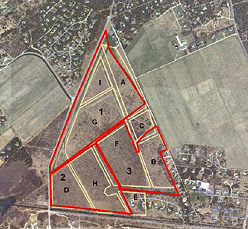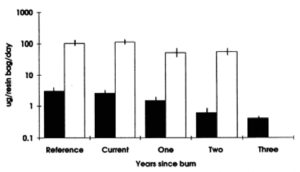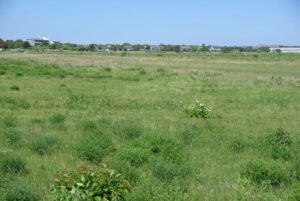Mowing and Burning at Katama Plains
Katama Plains Conservation Area is a 77-hectare (190-acre) property managed by The Nature Conservancy located in southeastern region of Martha’s Vineyard. It is one of the largest areas of high-quality and diverse sandplain grassland remaining on Martha’s Vineyard and in New England.
Prior to European settlement, this area likely had primarily low oak and pine woodland similar to other uncultivated areas of Martha’s Vineyard. Since the mid-1600s this area was used as pasture for sheep and cattle with occasional burning for management and grazed regularly up until the 1900s. Based on soil horizons there was likely soil tilling for crop agriculture before 1900, but the land has been protected since then. Aerial images and records show that Katama Airfield has been grassland since the 1920s and likely even earlier. In 1938 aerial photos, the Katama property was continuous grassland. Regular burning for management was implemented up until 1962. In 1988 the Department of Environmental Management acquired parts of Katama Plains and more recently the property has been managed with a combination of mowing and burning.
In 2008, monitoring observed 43 plant species and 98 percent of plant cover was native species including low sweet blueberry (Vaccinium angustifolium), Pennsylvania sedge (Carex pensylvanica), yellow wild indigo (Baptisia tinctoria), little bluestem (Schizachyrium scoparium), stiff aster (Lonactis linariifolia), small bayberry (Morella caroliniensis), and northern dewberry (Rubus flagellaris). There is a strong focus on conservation of rare plants at Katama Plains including Nantucket shadbush (Amelanchier nantucketensis), bushy frostweed (Crocanthemum dumosum), and others. There are also rare birds and butterflies, including Northern Harriers (Circus cyaneus) and occasionally Short-eared Owls (Asio flammeus).
Goals
- Reduce growth of woody vegetation.
- Increase native graminoid and forb species.
- Increase diversity of grassland animal species.
History

Figure 2. The red outlined areas are the three large management units established in 2000. Smaller yellow unites were established in the 1980s.
In 2000, The Nature Conservancy developed a management plan to apply prescribed fire and mowing during the same year. Specifically, they burned in spring (March to May) and mowed in summer (mid-August to fall) on a three-year rotation for six years among three large management units. A similar management regime is continued today. Prescribed fire applied every three to four years, and mowing every six years per unit. The interval of repeated management was selected to keep shrubs below 1.5 m height. A “control” unit is also mowed when shrubs are above 2 m tall. Pitch pines (Pinus rigida) are selectively cut when they appear, including in the control unit (Revised Management for Katama 2000).
Mowing at Katama Plains is designed to produce effects similar to those of growing season fires. Prescribed fires are applied during the dormant season in combination with mowing during the growing. Growing season mowing reduces shrubs more than dormant season mowing, which often reduces the timeframe and logistical and practical constraints of management. W. Patterson III (Interview) estimated that annual summer mowing at Katama significantly reduces shrub abundance in 5 to 6 years, while annual mowing in both June and August has the same effect in only 2 to 3 years.
Nantucket shadbush (Amelanchier nantucketensis) is a rare shrub that grows in the Katama Plains grasslands. Frequent mowing will have a negative impact on this rare plant, therefore the plants are marked and mowing specifically avoids them.
The mowing regime is designed to minimize effects on the nesting of birds including Northern Harriers (Circus cyaneus) and Grasshopper Sparrows (Ammodramus savannarum) by disturbing only one third of the area at a time. August mowing maintains potential Grasshopper Sparrow habitat. Grasshopper Sparrows formerly nested at Katama but do not nest there currently, and their absence is a cause for concern. It is also important for maintaining habitat for Northern Harriers not to mow grass or all shrubs directly to the ground. A mowing at a height of 0.5 m promotes quick vegetation recovery in some locations that are necessary to allow some shrub habitat for Northern Harrier nesting.

Figure 3. Available nitrogen in plots over in time since controlled burn. Black bar is average resin-bound nitrate and open bar is ammonium (Dudley and Lajtha 1993).
Dudley and Lajtha (1993) examined effects of burning at Katama Plains on soil nutrients and vegetation biomass. Results showed that available nitrogen increased immediately following a spring burn, but subsequently declined during the few years following a burn until the available nitrogen was lower than pre-burn conditions (Fig. 3). Further, above-ground shrub biomass was reduced after fire. Burning also decreased graminoid biomass compared with an unburned control area (Dudley and Lajtha 1993).
Wheeler (2015) analyzed species composition and cover data at Katama Plains. In this study, vegetation was monitored in 1 m2 plots in burn Unit F (Unit 3) and Unit G (Unit 1) from 1999 to 2014. Vegetation was monitored in 1999 or 2000, 2003 to 2008 and 2014. Burning occurred in the spring in 1989, 1994, 2000, 2005, and 2009 in unit F and in 1988, 1992, 1999, 2002, 2006, and 2010 in Unit G. Wheeler found that vegetation diversity did not change significantly over this time period in response to burning management. Total cover of all species increased slightly during the entire period. Further, forb cover increased slightly in the year following a burn, and shrub cover has increased over time. Thus, the burning treatments in this study have not stopped shrub growth. Shrub cover may be slightly reduced in the first year following a burn, but increasing burn frequency by one to two years would likely be impractical because of low fuel availability and potentially logistical constraints (Wheeler 2015). At Katama, the burning and mowing regime keeps the vegetation at a fairly steady state by reducing shrub growth, but a continuous application of fire in combination with other management techniques would likely be necessary to reduce existing shrub cover.
Dudley, J.L., & Lajtha, K. 1993. The effects of prescribed burning on nutrient availability and primary production in sandplain grasslands. The American Midland Naturalist 130: 286–298.
O’Neill, B. The Katama Airfield and the “race to save the coastal heathlands.” Undated. Vineyard Conservation Society. Available at: http://www.vineyardconservation.org/httpssitesgooglecomavineyardconservationorgvineyard-conservation-societyHome/the-katama-airfield-and-the-race-to-save-the-coastal-heathlands
Revised management plan for the Katama Plains Conservation Area, Edgartown, MA. 2000. Report to The Nature Conservancy, Boston, MA.
Wheeler, M. 2015. Katama Plains Conservation Area Aanalysis of 1999‐2014 Species Composition and Cover Data. Report to The Nature Conservancy, Boston, MA


